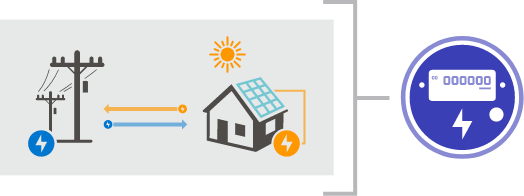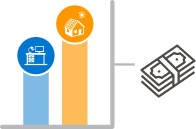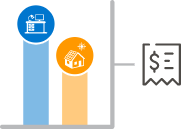Net Energy Metering (NEM)
The concept of Net Energy Metering is not new, it has existed for many years in California, but we understand it can be confusing, so here’s what you need to know.
What is Net Energy Metering (NEM)
If you have solar panels or other generation installed at your home or business, SDCP’s Net Energy Metering (NEM) program allows you to offset your monthly electricity consumption. With NEM, your electricity meter tracks how much electricity you’re using from the grid and how much surplus you send to the grid every month. The difference between the energy you produce and send to the grid, and the energy you use from the grid is called ‘net energy’.
The net energy is shown on the bill as negative usage when you’re a net generator or positive usage when you’re a net consumer. SDCP automatically tracks your usage and generation by Time-of-Use period and appropriately credits or charges you monthly based on your rate schedule.

Net Energy Metering – your electricity meter tracks how much electricity you’re using from the grid and how much surplus you send to the grid every month
How our NEM program works
SDCP is supportive of customers who generate renewable energy.
Please note: enrolling in SDCP service has no effect on your current rate schedules, including tiered and legacy rates, or participation in legacy NEM programs like NEM 1.0 or 2.0
Monthly account adjustments
If you are currently being served under NEM 1.0 or 2.0 and generate more electricity than you use in a given month, you will receive a credit for it at retail rates based on the Time-of-Use periods (e.g., Peak/Off-Peak) of your rate schedule. If you are instead on a tiered rate (e.g., DR), you will receive generation credits at the retail rate of the Total period value if you are a net generator of electricity. If you use more energy than you generate, you will be billed for it at the same retail rate. Essentially, we pay you monthly for the electricity you produce and send to the grid at the same rate that we would have charged you, if you were drawing power from the grid.
During months when you are a net generator, you generate credits that are banked for future use. During a month when you are a net consumer of electricity, we use those credits to help offset the cost. If you don’t have enough credits banked to cover all of the charges for any given month, we will bill you for the difference. This helps you to better budget electricity costs and avoid surprise true-up bills from SDCP.

If you generate more electricity than you use, you will receive a credit for it at retail rates

If you use more energy than you generate, you will be billed for it at the same retail rate
True-Up
At the end of the 12-month billing period, called the Relevant Period, during your standard True-Up period with SDG&E, we conduct an electricity true-up. We look at how much electricity (in kilowatt-hours or kWh) you generated and sent to the grid, and how much electricity you consumed from the grid. If you consumed more than you generated, you won’t get a big surprise bill since we do monthly account balancing. However, if you generated more than you consumed, we will pay you for adding clean electricity to the local grid. We do a cash out annually during true-up.
Net Surplus Compensation
When you are a net generator of electricity annually as discussed above, SDCP will pay you for that surplus electricity at the Net Surplus Compensation (NSC) rate + SDCP Bonus Incentive. The SDCP Bonus Incentive is three-quarters of a cent ($0.0075/kWh) on top of the standard NSC rate adopted by the California Public Utilities Commission. Net Surplus Compensation rates vary each month but our incentive will always be added to it. View the current NSC rate here.
To make things convenient for you, if your net surplus compensation amount is $100 or more, up to $2,500, per account, we will automatically issue you a check! If it’s less than $100, we will carry that forward to the next year to help offset any consumption charges in the future.
View An ExampleAnnual Account Billing and True-Up
How SDCP NEM benefits you, our customer
- Clean electricity all the time. With SDCP’s NEM program, you ensure that the electricity you consume, even during the night when your system isn’t producing, is clean and renewable thanks to our service.
- One single bill. You will continue to receive just the one monthly bill from SDG&E, which shows your monthly net electricity usage and production, and charges/credits.
- No annual bill shock. SDCP’s NEM program takes a more customer-friendly approach. Rather than billing you once per year and creating worry about a large true-up bill, any net consumption during the month is either covered by your NEM credits or billed to you monthly.
Note: SDG&E will continue to send you an annual True-Up bill for delivery charges. - Premium annual compensation rate. As a thank you for being an annual net producer of clean, renewable electricity, we add an additional $0.0075/kWh to the base Net Surplus Compensation rate from the utility.
- Automatic compensation. Gone are the days where you had to request a check from the utility. With SDCP, if your net surplus compensation amount is $100 or more, you will get a check automatically from us. If it’s less than $100, we will simply add that amount to your generation credits.
How SDCP’s NEM program compares with SDG&E’s NEM
SDCP’s NEM Program:
- Energy drawn from the grid is 50% to 100% renewable
- Credits/charges provided monthly
- No big bill shock at annual true-up from SDCP thanks to standard monthly billing of generation.
- Compensation for net annual surplus: wholesale rate + $0.0075 cents/kWh
- Automatic checks for compensation amounts of $100 or more, up to $2,500 per account.
SDG&E’s NEM Program:
- Energy is only 31% renewable
- Credits/charges provided once annually
- Annual billing for residential customers
- Compensated at wholesale rate
- Have to call contact center and request refund check
How to enroll in SDCP’s NEM Program
For new customers: We make it extremely easy to enroll in our NEM program. Once you install your system and SDG&E authorizes it to start operating, that’s it, you’re enrolled! We handle the communication with SDG&E on the backend to ensure you are enrolled into our program.
For existing solar customers within National City and the unincorporated areas of San Diego County: Your transition to SDCP and our NEM program will happen at the time of your annual true up with SDG&E to ensure you don’t lose any credits. Transitioning to SDCP service has no effect on your current rate schedule, including legacy rates, or participation in legacy NEM programs like NEM 1.0 or 2.0. Here’s the schedule of enrollment:
| True-Up Month | Enrollment Month |
| April | April 2023 |
| May | May 2023 |
| June | June 2023 |
| July | July 2023 |
| August | August 2023 |
| September | September 2023 |
| October | October 2023 |
| November | November 2023 |
| December | December 2023 |
| January | January 2024 |
| February | February 2024 |
| March | March 2024 |
